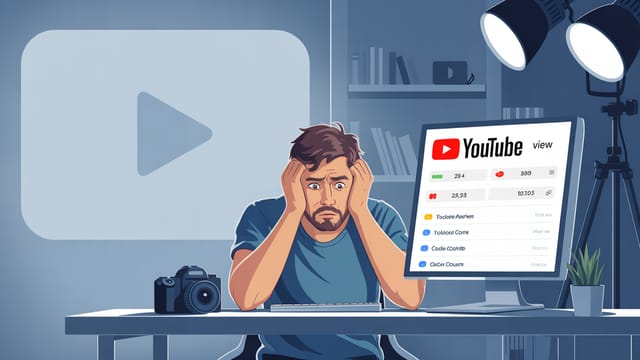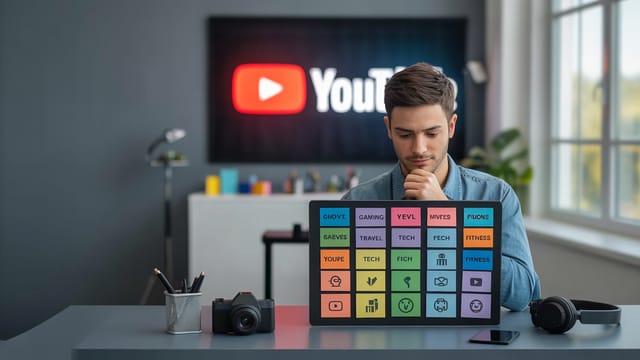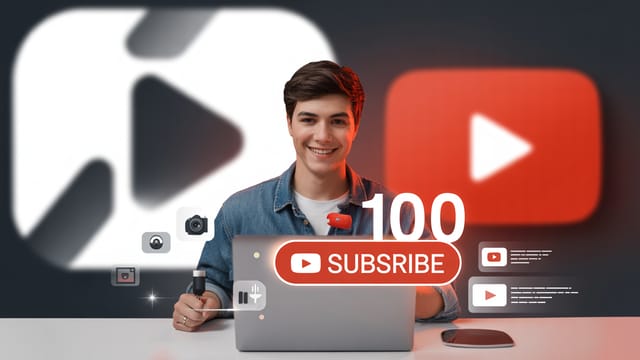
Ready to get your next 10,000 subscribers?
Join thousands of creators who use Subscribr to create faster, better YouTube videos.
Stop Guessing: How to Validate YouTube Video Ideas BEFORE You Film
You poured hours into scripting, filming, and editing. You hit publish, excitement building. Then... crickets. A handful of views, minimal engagement. It's a frustrating reality many YouTube creators face: the wasted effort on video ideas that simply don't resonate with an audience.
Struggling to consistently generate engaging video ideas and not knowing how to interpret data to improve your strategy are major roadblocks. But what if you could significantly increase the probability of your video succeeding before you ever hit record?
That's where video idea validation comes in. It's a strategic process that helps you gauge audience interest and demand for a topic, saving you countless hours of wasted effort and focusing your energy on content that has a real chance of success. This isn't about chasing fleeting trends; it's about building a sustainable content strategy based on what your target audience actually wants to watch.
Why Validating Your Video Ideas is Non-Negotiable
Think of validation as your pre-production insurance policy. In the competitive landscape of YouTube in 2025, simply making videos about what you find interesting isn't enough. While passion is essential, aligning that passion with audience demand is the key to growth.
Validating your ideas helps you:
- Save Time and Resources: Avoid investing hours in videos nobody is searching for or interested in.
- Increase Success Probability: Focus on topics with demonstrated audience demand, leading to more views, engagement, and subscribers.
- Understand Your Audience Better: Learn what truly resonates with your target viewers, informing your future content strategy.
- Reduce Creative Burnout: Experience the satisfaction of creating content that performs, fueling your motivation.
So, how do you move from guessing to strategic validation?
Method 1: Researching Audience Demand Where It Happens (On YouTube and Google)
The most direct way to know if people are interested in a topic is to see if they are actively searching for it. YouTube is the world's second-largest search engine, and Google Search also drives significant traffic to YouTube videos.
Forget outdated advice about keyword stuffing. Modern YouTube SEO and ideation are about understanding user intent and providing the best possible answer or content experience for that search query.
Here's how to research demand effectively:
- Utilize YouTube Search: Start typing your potential video idea into the YouTube Search bar. Pay attention to the autocomplete suggestions. These are real queries people are typing. Look at the videos that rank at the top for those terms. How many views do they have? Are they recent? High view counts on relevant, relatively recent videos are a strong indicator of existing demand (as highlighted by insights from top creators).
- Check Google Trends (for YouTube Search): This free tool is invaluable. Go to Google Trends, enter your topic, and crucially, change the search type filter from "Web Search" to "YouTube Search." This shows you the search interest for that topic specifically on YouTube over time. Steady or rising interest indicates a healthy, ongoing demand.
- Explore Related Questions: Tools like AnswerThePublic.com or AlsoAsked.com can reveal questions people are asking around your topic. This gives you ideas for specific angles or points to cover in your video that directly address audience curiosity.
Leveraging Tools: Tools like Subscribr's Research Assistant can help streamline this process by gathering information from the web related to your topic, while Subscribr's Niche & Video Ideation features are specifically designed to help you research and validate ideas by analyzing what's working in your niche.
Method 2: Analyzing Successful Content (Competitive & Outlier Analysis)
Another powerful validation technique is analyzing videos and channels that are already performing well. This isn't about copying; it's about understanding what resonates with the audience in your niche and identifying patterns you can learn from.
- Study Successful Channels: Use tools like Subscribr's Channel Intelligence or perform searches with youtube_channel_search to find successful channels in your niche. For instance, searching for "fitness" channels with over 50,000 subscribers and a decent views-to-subscriber ratio might reveal channels like @FitnessBlender or @HybridCalisthenics. Analyze their most popular videos. What topics do they cover? What formats do they use? What are their titles and thumbnails like?
- Identify Outlier Videos: Look for videos that significantly outperform a channel's typical view count (an outlier). These videos often contain a topic, angle, or packaging element that struck a chord with a wider audience. You can find high-performing videos in various niches using youtube_video_search with filters like
min_views: 1000000. For example, searching for "tech review" videos with over a million views might show high performers like Marques Brownlee's Apple Vision Pro Review: Tomorrow's Ideas... Today's Tech!. Analyze why these specific videos did so well. Was it the topic, the timing, the unique angle, or the packaging? - Analyze Outside Your Niche: Sometimes, the best inspiration and validation come from unexpected places. Look for outlier videos in completely different niches. Can you adapt the format or storytelling style of a successful cooking video to your tech channel, or a popular commentary format to your fitness content? This "idea transfer" or "Lego" approach (combining proven elements) is a powerful validation technique mentioned by experienced creators.
Leveraging Tools: Subscribr's Video Intelligence and Research Assistant can help break down successful videos, analyze their structure, hooks, and content organization, and even extract transcripts for deeper analysis.
Method 3: Gathering Direct Audience Feedback
Sometimes, the simplest way to validate an idea is to ask your potential audience directly.
- Poll Your Existing Audience: If you have an existing community (even a small one), use YouTube polls, Instagram stories, or community tab posts to ask which ideas they'd be most interested in seeing.
- Engage in Communities: Participate in online forums, social media groups, or Discord servers related to your niche. Pay attention to the questions people are asking and the problems they're trying to solve. You can also directly ask for feedback on potential video topics (without being overly promotional). Engaging directly with potential viewers helps you understand their needs and desires, as highlighted by creators who use this validation framework.
- Ask Trusted Peers: Share your ideas with other creators or experienced individuals you trust. They can offer valuable external perspectives and point out potential weaknesses or opportunities you might have missed. Seeking high-level feedback from those with experience can significantly increase your probability of success.
This direct approach gives you qualitative data that complements your quantitative research.
Method 4: Small-Scale Testing and Idea Transfer
Before committing to a full-length, high-production video, consider testing the waters with a smaller piece of content.
- Use YouTube Shorts or other platforms: Create a short, punchy version of your idea as a YouTube Short, TikTok, or Instagram Reel. See how it performs. Does it grab attention? Do people engage? This can be a quick way to validate interest in a concept or hook.
- Adapt Proven Concepts: As mentioned earlier, look for video formats or angles that have worked well for others (even outside your niche) and brainstorm how you can apply your unique perspective to that proven structure. This reduces the risk compared to trying a completely novel, untested format.
By mitigating loss through small-scale testing and leveraging proven structures, you raise the average performance floor of your content. It's often easier to identify and discard bad ideas early than to salvage a poorly performing video later.
Using YouTube Analytics to Refine Your Validation Process
While validation happens before filming, your YouTube Analytics provide crucial feedback after you publish. Analyzing the performance of your validated ideas helps you refine your future validation process.
Look at metrics like:
- Audience Retention: Where are viewers dropping off? What parts of the video are they rewatching? This tells you what content is most engaging.
- Click-Through Rate (CTR): How effective were your title and thumbnail at getting people to click? This is a key indicator of how well you packaged the idea based on audience expectations.
- Engagement Metrics (Likes, Comments, Shares): Did the video spark conversation or encourage interaction?
- Traffic Sources: Where are viewers finding your video? Is it through YouTube Search, Suggested Videos, or external sources?
Understanding which validated ideas performed best and why (based on analytics) allows you to double down on successful formats, topics, and packaging styles in the future. Subscribr's Channel Intelligence and the native YouTube Analytics dashboard are essential for this ongoing analysis.
Subscribr: Your All-In-One Validation Hub
Putting all these validation techniques together might sound like a lot of work. This is where a platform built specifically for creators like Subscribr becomes invaluable.
Instead of juggling multiple tools and spreadsheets, Subscribr integrates research, planning, and analysis into a single workflow. Use Subscribr's Research Assistant to gather information, Niche & Video Ideation to explore potential topics and analyze what's working, and Channel & Video Intelligence to dive deep into the performance of successful content and identify outliers. The AI Chat can even help you brainstorm and refine your ideas based on data.
By using Subscribr, you can systematically research demand, analyze successful examples, and plan content with a higher probability of success, reducing wasted effort and increasing your efficiency – a skill that is highly valued and directly contributes to your potential for monetization and growth.
Conclusion
Stop letting great effort go to waste on unvalidated ideas. By implementing a strategic validation process using audience demand research, competitive analysis, direct feedback, and small-scale testing, you can dramatically improve your batting average on YouTube.
Use the tools available to you, like YouTube Search, Google Trends, YouTube Analytics, and the comprehensive features within Subscribr, to understand what your audience is truly looking for. Validate your ideas before you film, and you'll be well on your way to creating content that not only gets watched but helps you build a thriving channel.





